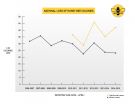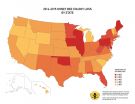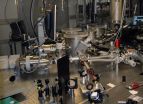(Press-News.org) Beekeepers across the United States lost more than 40 percent of their honey bee colonies during the year spanning April 2014 to April 2015, according to the latest results of an annual nationwide survey. While winter loss rates improved slightly compared to last year, summer losses--and consequently, total annual losses--were more severe. Commercial beekeepers were hit particularly hard by the high rate of summer losses, which outstripped winter losses for the first time in five years, stoking concerns over the long-term trend of poor health in honey bee colonies.
The survey, which asks both commercial and small-scale beekeepers to track the health and survival rates of their honey bee colonies, is conducted each year by the Bee Informed Partnership in collaboration with the Apiary Inspectors of America, with funding from the U.S. Department of Agriculture (USDA). A summary of the 2014-2015 results is available upon request prior to May 13, 2015; thereafter the results will be added to previous years' results publicly available on the Bee Informed website.
"We traditionally thought of winter losses as a more important indicator of health, because surviving the cold winter months is a crucial test for any bee colony," said Dennis vanEngelsdorp, an assistant professor of entomology at the University of Maryland and project director for the Bee Informed Partnership. "But we now know that summer loss rates are significant too. This is especially so for commercial beekeepers, who are now losing more colonies in the summertime compared to the winter. Years ago, this was unheard of."
Beekeepers who responded to the survey lost a total of 42.1 percent of their colonies over the course of the year. Winter loss rates decreased from 23.7 percent last year to 23.1 percent this year, while summer loss rates increased from 19.8 percent to 27.4 percent.
Among backyard beekeepers (defined as those who manage fewer than 50 colonies), a clear culprit in losses is the varroa mite, a lethal parasite that can easily spread between colonies. Among commercial beekeepers, the causes of the majority of losses are not as clear.
"Backyard beekeepers were more prone to heavy mite infestations, but we believe that is because a majority of them are not taking appropriate steps to control mites," vanEngelsdorp said. "Commercial keepers were particularly prone to summer losses. But they typically take more aggressive action against varroa mites, so there must be other factors at play."
This is the ninth year of the winter loss survey, and the fifth year to include summer and annual losses in addition to winter loss data. More than 6,000 beekeepers from all 50 states responded to this year's survey. All told, these beekeepers are responsible for nearly 15 percent of the nation's estimated 2.74 million managed honey bee colonies.
The survey is part of a larger research effort to understand why honey bee colonies are in such poor health, and what can be done to manage the situation. Colony losses present a financial burden for beekeepers, and can lead to shortages among the many crops that depend on honey bees as pollinators. Some crops, such as almonds, depend entirely on honey bees for pollination. Estimates of the total economic value of honey bee pollination services range between $10 billion and $15 billion annually.
"The winter loss numbers are more hopeful especially combined with the fact that we have not seen much sign of Colony Collapse Disorder (CCD) for several years, but such high colony losses in the summer and year-round remain very troubling," said Jeffery Pettis, a senior entomologist at U.S. Department of Agriculture and a co-coordinator of the survey. "If beekeepers are going to meet the growing demand for pollination services, researchers need to find better answers to the host of stresses that lead to both winter and summer colony losses."
INFORMATION:
This survey was conducted by the Bee Informed Partnership, which receives a majority of its funding from the National Institute of Food and Agriculture of the U.S. Department of Agriculture (USDA) (Award No. 2011-67007-20017). The content of this article does not necessarily reflect the views of the USDA.
A summary of the 2014-2015 results is available upon request prior to May 13, 2015; thereafter the results will be added to previous years' results publicly available on the Bee Informed website.
Media Relations Contact: Matthew Wright, 301-405-9267, mewright@umd.edu
University of Maryland
College of Computer, Mathematical, and Natural Sciences
2300 Symons Hall
College Park, MD 20742
http://www.cmns.umd.edu
@UMDscience
About the College of Computer, Mathematical, and Natural Sciences
The College of Computer, Mathematical, and Natural Sciences at the University of Maryland educates more than 7,000 future scientific leaders in its undergraduate and graduate programs each year. The college's 10 departments and more than a dozen interdisciplinary research centers foster scientific discovery with annual sponsored research funding exceeding $150 million.
MANHASSET, NY -- The Feinstein Institute for Medical Research, the research arm of the North Shore-LIJ Health System, and SetPoint Medical Inc., a biomedical technology company, today released the results of research on the therapeutic potential of vagus nerve stimulation. In a paper published by Bioelectronic Medicine, Kevin J. Tracey, MD, and his colleagues at the Feinstein Institute, explore how low-level electrical stimulation interacts with the body's nerves to reduce inflammation, a fundamental goal of bioelectronic medicine.
Prior to this study, it was not understood ...
Scientists at The University of Manchester have made an important discovery about how certain cells stick to each other to form tissue.
The team from the Faculty of Life Sciences studied how cells in the skin and heart are bound together through structures called desmosomes. They wanted to understand how these junctions between the cells in the tissue are so strong.
Desmosomes are specialised for strong adhesion. They bind the tissue cells together to resist the rigours of everyday life and their failure can result in diseases of the skin and heart, including sudden ...
A part of the performance degradation mechanism of the advanced, electrodeless, helicon plasma thruster with a magnetic nozzle, has been revealed by the research group of Dr. Kazunori Takahashi and Prof. Akira Ando at Tohoku University's Department of Electrical Engineering.
An electric propulsion device is a main engine, and a key piece of technology for space development and exploration. Charged particles are produced by electric discharge and accelerated, i.e. momentum is transferred to them via electromagnetic fields. The thrust force is equivalent to the momentum ...
Digital signatures are mechanisms for authenticating the validity or authorship of a certain digital message and they aim to be digital counterparts to real (or analog) signatures. The concept was introduced by Diffie and Hellman in 1976. Notice that, when certified, digital signatures have the same legal power as traditional signatures.
With the advent of quantum computation new threats to security became a near future reality and all known digital signatures schemes are vulnerable, compromising fundamental properties of signature schemes: authenticity and authorship ...
Chicago (13 May, 2015)- In the latest issue of the Bulletin of Atomic Scientists, published by SAGE, experts from the United States, Russia, and China present global perspectives on ambitious nuclear modernization programs that the world's nuclear-armed countries have begun.
In the latest edition of the Bulletin's Global Forum, Georgetown University professor Matthew Kroenig argues that:
"Failure to modernize would not contribute to disarmament - but more than that, it would be irresponsible. A crippled US nuclear force would embolden enemies, frighten allies, generate ...
The recombination of electron shells in molecules, taking just a few dozen attoseconds (a billionth of a billionth of a second), can now be viewed "live," thanks to a new method developed by MIPT researchers and their colleagues from Denmark, Japan and Switzerland. An article detailing the results of their study has been published in the journal Nature Communications.
In recent years, scientists have learned how to study ultrafast processes taking place at the atomic and molecular levels, and research in this field is expected to yield some very important results. In ...
This news release is available in German. Chloroplasts are the solar cells of plants and green algae. In a process called photosynthesis, light energy is used to produce biochemical energy and the oxygen we breathe. Thus, photosynthesis is one of the most important biological processes on the planet. A central part of photosynthesis takes place in a specialized structure within chloroplasts, the thylakoid membrane system. Despite its apparent important function, until now it was not clear how this specialized internal membrane system is actually formed. In a collaborative ...
Amsterdam, May 13, 2015 - A new family of molecules that kill cancer cells and protect healthy cells could be used to treat a number of different cancers, including cervical, breast, ovarian and lung cancers. Research published in EBioMedicine shows that as well as targeting and killing cancer cells, the molecules generate a protective effect against toxic chemicals in healthy cells.
Cells can become cancerous when their DNA is damaged. Many different things can cause DNA damage, including smoking, chemicals and radiation; understanding exactly what happens at the point ...
London/Zurich, May 13, 2015: Children in European countries tend to report higher levels of satisfaction with their friendships while children in African countries tend to be happier with their school lives. Children in northern European countries are particularly dissatisfied with their appearance and self-confidence. Most of the 50,000 children in the 15 countries rated their satisfaction with life as a whole (on a scale from zero to ten) positively, but the percentage of children with very high well-being (10 out of 10) varied from around 78% in Turkey and 77% in Romania ...
The time needed to genetically sequence the bacteria causing tuberculosis (Mtb) from patient samples has been reduced from weeks to days using a new technique developed by a UCL-led team. This could help health service providers to better treat disease, control transmission of this infection, and monitor outbreaks.
Tuberculosis (TB) disease rates in some parts of London are as high as in Sub-Saharan Africa, and drug-resistant strains are becoming increasingly common. These require specific treatments, and if doctors know that a bug is resistant they can start therapy ...



